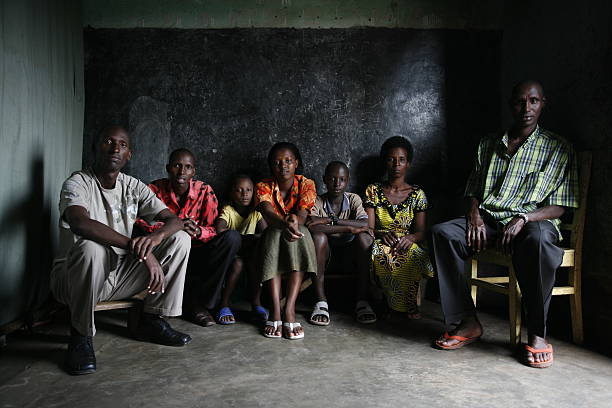
Background
The following reports, videos, images, and books include details on the Gatumba Massacre, and are listed chronologically. These include quotations from and full interviews with survivors. The languages in these sources vary between English, French and Kinyamulenge.
Reports:
Fernando del Mundo, “Massacre in a refugee camp in Burundi”, UNHCR, 16 August 2004.
United Nations News, “In wake of refugee massacre, Burundi agrees to UN request to set up secure camp”, 16 August 2004.
Andrew Meldrum, “Massacred refugees buried”, The Guardian, 17 August 2004.
Azarias Ruberwa Manywa, “Le cahier de charge du RCD remis à Thabo Mbeki”, 29 August, 2004
Human Rights Watch, “Burundi: The Gatumba Massacre: War Crimes and Political Agendas”, Briefing Paper, September 2004.
Stephanie Wolters, “Continuing Instability in the Kivus: Testing the DRC transition to the limit”,” Institute for Security Studies, October 2004.
United Nations Security Council, “Joint report of the United Nations Organization Mission in the Democratic Republic of the Congo, the United Nations Operation in Burundi and the Office of the United Nations High Commissioner for Human Rights into the Gatumba massacre”, 5 October 2004.
Aloys Tegara, Christiane Kayser, and Onesphore Sematumba,“Devoir de mémoire et responsabilité collective pour l'avenir”, December 2004
Cather-Lune Grayson, “Survivors of Burundi’s Gatumba camp massacre head to the United States”, UNHCR USA, 19 March 2007.
The New Humanitarian, “Massacre Survivors Resettle in the US”, 19 March 2007.
Nina Bernstein, “Safe From Persecution, Still Bearing Its Scars”, New York Times, 5 August 2007.
Michael Pertnoy and Michael Kleiman, “The Last Survivor: The Banyamulenge”, The Huffington Post, 17 April 2009.
Human Rights Watch, “Selling Justice Short: Why Accountability Matters for Peace”, 7 July 2009.
Jazmine Ulloa, “Congolese remember victims of massacre,” Boston Globe, 16 August 2009 [requires subscription].
Chris Campbell, ““Bearing witness to war’s horror”, St. Louis Post-Dispatch, 13 April 2011 [requires subscription].
Tim Fenster, “Congolese refugees gather in Syracuse to remember rebel attack that killed 160”, The Post-Standard, 13 August 2011.
The New Times, “Gatumba massacre victims honoured”, 15 August 2012.
Zoeann Murphy, “‘He was alive. They burned him’: Congolese refugees call for long-overdue justice”, The Washington Post, 19 September 2014.
Georgianne Nienaber, “She Survived the Bullets and Flames of Gatumba”, The Huffington Post, 18 August 2015.
All Over Albany, “Finding refuge: Olivier Mandevu”, 17 August 2017.
Human Rights Watch, “Burundi: 15 Years On, No Justice for Gatumba Massacre”,13 August 2019.
Maggie Wagner, “Sixteen Years After the Massacres of the Banyamulenge Refugees in Gatumba, Burundi”, Austin Refugee Roundtable, 12 August 2020.
Luigi Elongui, “Gatumba, 16 Years Later: The Names of Those Responsible are Known”, Maelezo Kongo, 15 August 2020.
William Basimiké, “DRC: the Banyamulenge demand justice, seventeen years after the Gatumba massacre”, RFI, 14 August 2021.
Videos and Images:
“WXXINews interview the survivors Sandra Uwiringiyimana and Adele Kibasumba”, August 2014.
“Ryajoro Ryibibazo [Night of Troubles],” memorial song performed by various artists”.
“Footage [set to music] of the memorial following the attack”, August 2004.
“Gatumba Refugee Survivors Foundation produced documentary [including list of victim names]”, 2005.
“Congolese Refugees Cry out for Justice,” Washington Post documentary featuring survivors, the Mandevu family”, 19 September 2014.
“Post-attack footage of bodily remains and interview with Azarias Ruberwa”, August 2004.
“Le Journal news report on the Burundi memorial service”, 23 August 2012.
“Associated Press images taken after the attack by Aloys Niyoyita”.
Books:
Thomas Turner, The Congo Wars: Conflict, Myth and Reality (Zed Books, 2007) pp. 243
Gerard Prunier, Africa’s World War: Congo, the Rwandan Genocide, and the Making of a Continental Catastrophe (Oxford University Press, 2008) pp. 576
Filip Reyntjens, The Great African War: Congo and Regional Geopolitics, 1996-2006 (Cambridge University Press, 2009) pp. 327
Maja Janmyr, Protecting Civilians in Refugee Camps: Unable and Unwilling States, UNHCR and International Responsibility (Martinus Nijhoff Publishers, 2013) pp. 412
Jonathon Butoto, Status of Bad Memories: the Survivor of Oppression in the Darkest War of Democratic Republic of the Congo (Xlibris Corporation, 2016) pp. 100
Sandra Uwiringiyimana, How Dare the Sun Rise (Katherine Tegen Books, 2017) pp. 288
-

Gatumba Massacre, Background Essay
Christopher Davey, Ezra Schrader, Fidele Sebahizi, and Jean Paul Iranzi
On August 13th 2004, 166 people were killed and 106 were wounded at the UN’s Gatumba refugee camp in Burundi. Nearly all the victims were members of the Banyamulenge community, a Congolese Tutsi ethnic group who were deliberately targeted in the attack. The massacre was carried out by the Forces Nationales pour la Liberation (FNL), a Hutu supremacist rebel group fighting in Burundi’s civil war. Understanding the Gatumba Massacre requires understanding what forced those Banyamulenge refugees to flee their homes in the Democratic Republic of the Congo (DRC), and why the FNL targeted them. This background essay addresses the context historical and events that led to the Gatumba Massacre.
This essay is co-authored by Christopher P. Davey, Jean Paul Iranzi, Ezra Schrader, and Fidele Sebahizi.


